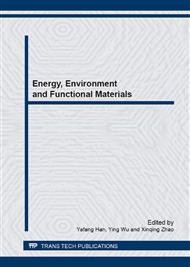[1]
DING Ning, GAO Feng, WANG Zhihong. Comparative analysis of primary aluminum and recycled aluminum on energy consumption and greenhouse gas emission, The Chinese Journal of Nonferrous Metals, Forum Vol. 10 (2012), pp.2908-2915
Google Scholar
[2]
EAA, Environment profile report for the European Aluminum Industry, Brussels, 2000.
Google Scholar
[3]
EAA, Environment profile report for the European Aluminum Industry. Primary Aluminum update-year 2002; Semi-finished aluminum products and process scrap recycling Update-year 2002; Aluminum recycling in LCA, Brussels, 2005.
Google Scholar
[4]
EAA, Environment profile report for the European Aluminum Industry, Life cycle inventory data for aluminum production and transformation process in Europe, Brussels, 2008.
Google Scholar
[5]
IAI. Life Cycle Assessment of Aluminum: Inventory Data for the Worldwide Primary Aluminum Industry〔EB/ OL〕, London, 2003.
Google Scholar
[6]
IAI. Life Cycle Assessment of Aluminum: Inventory Data for the Worldwide Primary Aluminum Industry〔EB/ OL〕, London, 2007.
Google Scholar
[7]
AA, EAA, IAI, Improving Sustainability in the Transport Sector Through Weight Reduction and the Application of Aluminum. 2007.
Google Scholar
[8]
AA, Life Cycle Inventory Report for the North American Aluminum Industry, Washington, 1998.
Google Scholar
[9]
Kim S K. Effect of product quality on life cycle assessment in aluminum die casting process[C]. Kitakyushu, Japan: 2007.
Google Scholar
[10]
Bertram M, Buxmann K, Furrer P. Analysis of greenhouse gas emissions related to aluminum transport applications - Springer[J], The International Journal of Life Cycle Assessment. 2009, Volume 14(Issue 1 Supplement): 62-69.
DOI: 10.1007/s11367-008-0058-0
Google Scholar
[11]
Liu G, Bangs C E, Müller D B. Unearthing Potentials for Decarbonizing the U.S. Aluminum Cycle[J]. Environmental Science & Technology, 2011, 45(22): 9515-9522.
DOI: 10.1021/es202211w
Google Scholar
[12]
YUE Qiang, WANG Heming, LU Zhongwu. Analysis of aluminum cycle from 2003 to 2007 in China, Resource Sciences, Forum Vol. 03 (2010), pp.472-477
Google Scholar
[13]
Chen W, Shi L, Qian Y. Substance flow analysis of aluminum in mainland China for 2001, 2004 and 2007: Exploring its initial sources, eventual sinks and the pathways linking them[J]. Resources, Conservation and Recycling, Forum Vol. 54 (2010), pp.557-570
DOI: 10.1016/j.resconrec.2009.10.013
Google Scholar
[14]
WU Juanni, WAN Hongyan, CHEN Weiqiang, SHI Lei. Quantifying energy consumption and greenhouse gas emissions of the primary aluminum industry in China, J Tsinghua Univ. (Sci & Tech), Forum Vol. 50 (2010), pp.407-410
Google Scholar
[15]
Du J D, Han W J, Peng Y H, et al. Potential for reducing GHG emissions and energy consumption from implementing the aluminum intensive vehicle fleet in China[J]. Energy Forum Vol. 35 (2010), pp.4671-4678
DOI: 10.1016/j.energy.2010.09.037
Google Scholar
[16]
Council of Yearbook of Nonferrous Metal Industry of China Editors, The yearbook of Nonferrous Metal Industry of China 2004.
Google Scholar
[17]
Council of Yearbook of Nonferrous Metal Industry of China Editors, The yearbook of Nonferrous Metal Industry of China 2007.
Google Scholar
[18]
Council of Yearbook of Nonferrous Metal Industry of China Editors, The yearbook of Nonferrous Metal Industry of China 2009.
Google Scholar
[19]
Council of Yearbook of Nonferrous Metal Industry of China Editors, The yearbook of Nonferrous Metal Industry of China 2011.
Google Scholar
[20]
DING Ning, GAO Feng, WANG Zhihong, Analysis of the energy consumption and greenhouse gas emissions in aluminum extrusion production. Light Metals. Forum Vol. S1 (2011), pp.320-324
Google Scholar
[21]
Di Xianghua, Nie Zuoren, et al. Life cycle inventory for electricity generation in China - Springer[J]. The International Journal of Life Cycle Assessment, 2007, Volume 12(Issue 4): 217-224. Forum Vol. 12 (2007), pp.217-224
DOI: 10.1065/lca2007.05.331
Google Scholar
[22]
LUO Lifen, QIN Qingdong, QIU Shilin, Studying status of PFC emission reduction during aluminum production. Light Metals. Forum Vol. 10 (2010), pp.31-34
Google Scholar
[23]
ZHOU Hemin, Life Cycle Assessment on Iron and Steel Processes. Doctoral Dissertation, Beijing University of Technology
Google Scholar


